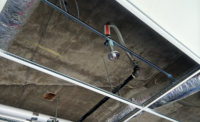Walking through a typical public building, it’s easy to point out the fire protection and life safety systems that ensure the safety of building occupants in the event of an emergency.
Exit signs over a means of egress; audible visible appliances and manual pull stations mounted on the walls; security systems and generators in place; smoke detectors as well as sprinkler systems installed at the ceiling; vents for the HVAC system; and the elevator recall — these are all examples of individual fire protection and life safety systems installed in buildings around the world.
Each contributes a valuable tool in the event of an emergency, but not one of these systems is exclusively capable of detecting, notifying, suppressing and ensuring the safe egress of building occupants, or allowing first responders to effectively do their jobs in an emergency situation.
These systems depend on each other to collectively ensure that life safety is achieved. Many of us in the fire protection industry know these systems are individually tested (also known as acceptance testing) in order for the building owner to receive the certificate of occupancy. But what happens to the value of all these systems if they are not tested to confirm the “handshake” between them?
The assumption, and root of the problem, is that many people think integrated system testing already is being completed prior to the facility being occupied. Building owners assume when they receive the certificate of occupancy that all the systems have been tested and will perform as their intended design, while occupants assume these systems are tested and will function in an emergency.
The first thing to know about integrated system testing is that many of these systems are not tested holistically to confirm they will function together to perform in the event of an emergency.
This is where NFPA 4, Standard for Integrated Fire Protection and Life Safety System Testing, comes into action. An integrated systems test is defined in the first edition (2015 edition of NFPA 4) as a test performed on fire protection and life safety systems. This confirms that operation, interaction and coordination of multiple individual systems perform their intended function.
Until 2015, no single NFPA code or standard mandated integrated fire protection and life safety system testing. That’s because when fire protection systems were first installed in the late 19th century, the systems were designed as individual systems with their own goals to function independently. As buildings became more complex and technology advanced, the platform for these systems to interact with one another was created. However, the scopes of the NFPA standards, which cover the design, installation and acceptance testing of the individual systems, remained the same and a critical gap developed.
Not new to the block
Although NFPA 4 is new to the fire protection industry the concept of integrated testing is not. The insurance industry has applied the concept of integrated system testing intermittently since the 1930s when NFPA 1971, Standard on Central Station Service, was published. NFPA 1971 required the inspection and testing of sprinkler water-flow valves to be monitored by the listed central station, ensuring sprinkler system activations were addressed in a timely manner.
In 1993, when the first edition of NFPA 72, National Fire Alarm Code, was published, all fire alarm systems were required to include water-flow switch testing as part of the regular testing protocol; interface equipment connections were required to be tested by operating or simulating the equipment being supervised. NFPA 72 provided a reference for building officials to point to, but logistically the testing was challenging to enforce because it was difficult to get all the right people together at once to test the systems.
Currently, the installation standards (i.e. NFPA 13, NFPA 72) require testing of installed systems to ensure installation compliance to the individual standard. NFPA 4 distinguishes itself from the rest of NFPA codes and standards in that it requires systems already individually tested to work together as a “system of systems.”
The first published edition of NFPA 4 does not mean all buildings need to conduct periodic integrated system testing. The scope of the standard is to provide the minimum requirements for testing new or existing integrated fire protection and life safety systems where such testing is required by the design documents, commissioning plan, governing laws, codes, regulations or standards. In addition, NFPA 4 does not provide prescriptive lists of test scenarios, testing frequencies or a list of specific members required to be on the integrated system testing team. Since the level of testing varies from one facility to another, NFPA 4 delivers a protocol that will verify the integrated fire protection and life safety systems perform as intended.
Test, test
The five major items outlined in NFPA 4 include forming the integrated system testing team, writing the test plan, developing test scenarios and test frequencies, as well as documenting that information in a final test report to submit to the owner. The scalability of a project, the number of systems installed in a facility, the complexity of those systems, the number of zones for each system and several other factors need to be analyzed to determine how integrated system testing will be conducted.
The standard outlines who could be on the integrated system testing team. It also lists the required qualifications and responsibilities associated with the specific position on the team. Some projects could have one member on the team, while others have several. The required test plans are project-dependent and will vary in length, but 11 specific items are required to be included in the test plan in accordance with NFPA 4.
Writing a test plan provides a document the test team can use to conduct the test without having to ask any questions. The test scenarios required by NFPA 4 are not prescriptive to the type of system, but are very common scenarios that can be conducted for most buildings, requiring events and combination of events, including but not limited to the loss of normal power, water flow and presence of smoke. When developing the test scenarios, it’s important to consider any recent incidents that occurred in the jurisdiction, data associated with the types of fire protection and life safety systems installed, as well as data on the occupancy classification to determine what the installed systems or occupancy could be subjected to and to simulate those situations in the test scenarios.
How much testing is enough?
Evaluating how often this testing needs to occur depends on the type of integration, complexity of the integration and the supervision provided. Three testing frequencies are outlined in NFPA 4 and include initial integrated system tests, periodic integrated system tests and trigger-based testing for existing systems. Typically testing is required when:
- A new system is installed and integrated into an existing system;
- Existing systems are modified to become part of an integrated system; and
- Changes are made for an individual system that is part of an integrated system.
NFPA 4 defines different tests (i.e. pre-functional test, end-to-end test, control group test). It’s important to recognize the differences between these tests and know when each of them could apply. The purpose of this testing is not to require testing every time a strobe is replaced, but rather to test the portions of the integrated system that are affected by the modification.
At the conclusion of the integrated system testing, a list of the members on the integrated testing team, the lists of systems tested, narratives of the test scenarios, and associated results and test frequencies are required to be submitted to the owner.
This documentation essentially is a road map that illustrates how every system in the building functions and how the systems interact with one other. These systems are designed by engineers, underwritten by insurance companies, installed by contractors, inspected and approved by enforcers, maintained by facility managers and relied upon in emergency situations by building occupants.
Many resources go into ensuring life safety, but how valuable are the systems if they are not tested to function together? Integrated system testing allows building owners to understand the systems installed in their facility and to know they will function as designed in the event of an emergency. That peace of mind is invaluable.
Integrated system testing transforms the public’s assumption of properly functioning fire protection and life safety systems into reality. For more information please visit www.nfpa.org/4.
This article was originally titled “Have the right plan” in the May 2016 Fire Protection and Design section of PM Engineer.



